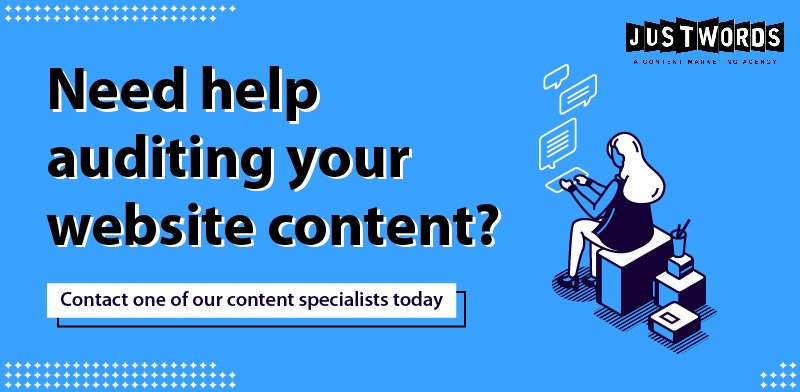Do you remember the last time you performed a content audit? Nope? Don’t worry, you aren’t alone.
Most businesses are so focused on creating new, unique content that they forget about the existing one. And the result? Website reek of outdated, stale content that affects the SEO ranking.
So, how do you perform a content audit? And before moving to it, what exactly is it? Let’s find out all about it here.
What is Content Audit?
A content audit is a strategic process of identifying, analysing, and evaluating your existing website content for its strengths and weaknesses. It is done to check if the content meets your business objectives. And also, to discover opportunities to meet your goals.
You can generally categorise content audits by extensiveness or based on your goals. To mention a few ways audit is carried on are:
-
Full Content Audit
As the name suggests, a full content audit involves the entire content inventory, organising it, and finally analysing the content types on your website.
-
Partial Content Audit
A partial audit will involve a specific category. For example, social media content, blog content writing, or niche-specific content, etc. You can also specify it according to the time period like the last six months or a calendar year.
-
Content Marketing Audit
This audit involves analysing data for marketing benefit. You can include data like content type, word count, page visits, location, time spent on each page, social media engagement metrics, and so on. The content marketing audit will let you identify the topics your audiences love and help you create similar in the future.
-
SEO Content Audit
This type involves not only cataloguing the content assets but also their keywords, backlinks, traffic sources, bounce rates, conversions, SERPs rankings, and similar metrics for each post. This will help you in understanding the changes that you need to make for better search engine rankings.
Why Do You Need It?
Now, your next question will be that why you need it? So, here’s an overview of what a content audit will reveal for you:
- Your most successful pages
- Topics and ideas your audience liked the most
- Pages that failed to perform
- Need to update any blog post or content ideas for better performance
If this isn’t enough reason for you to invest hours in doing a content audit, then here are three major benefits for business that will compel you to carry out the audit.
1. To Improve Overall SEO Performance
A content audit will tell you which pages generate little or no traffic conversion at all suggesting you improve the content matter. It will also reveal the content assets that need to be prune.
2. Boost Engagement
An audit will also bring forward the pages and topics that bring the most engagement to your website. When you analyse these web pages, you will be able to dissect the factors that your audiences like. And you can use them on other blog posts or assets to bring in a similar effect.
3. To Identify Low-Hanging Content Ideas
This process will also help you to understand several opportunities in improving your SEO or content gaps. Many of your blog pages may only need a change in title or mate description to rank better.
Now that we are clear on the what, why, and when of the content audits, let’s check how to conduct them.
How to Perform a Content Audit?
It’s definitely a lengthy process, but it isn’t as complicated as many think of it. You just need to follow these simple 4 steps to do a content audit of your website and increase organic traffic.
Step 1: Catalogue Your Content Inventory
Before you start with the audit, you need to have a perfect idea of all the content assets your company has published. So, your first step is to make a spreadsheet template that includes all your content assets.
You can do this step in two ways:
- Manually
Enter all the content lists manually in the spreadsheet. Make use of your sitemap as a guide. You can also use Google Search Console to cross-verify this data.
You can use this method in the case of small websites with fewer web pages.
- Use Crawler
Another method is to use a crawler for building a list of all the URLs on your website. Export this data into a CSV file and incorporate it into a spreadsheet later.
This method comes in handy if you have a website with more web pages.
Step 2: Gather Your Data
Your next step should be to gather data about these pages to help you evaluate the assets.
Start by gathering information about each blog post like:
- Title
- Word count
- Content-type
- Author
- Published Date
- Keywords
- CTA (Call-to-action)
- Conversion goals
- Time spent on each page
- Bounce rate
- Shares and comments
If you are looking for an in-depth SEO audit, then you might need to add some additional metrics like:
- Unique visitors
- Keyword saturation
- Inbound links
- Outbound links
- SERP ranking
- Meta description
- Meta tag
- Keyword in headings and subheadings
- Keyword in Alt tag
- Referring URLs
You can find most of this data using Google Analytics or Google Search Console. However, for advanced SEO data, you may have to look at other SEO tools for analytics.
Step 3: Crawl the Website Content
Now that you have all the necessary information about the website, your next step should be to audit the content as a whole. This will help you identify the problems with content that you may have missed during SEO analysis.
Using a crawler tool for auditing website content will help you understand basic on-page SEO checks like too long titles, same tag, or duplicate contents.
Step 4: Analyse the Data
Once you have all the audit data in front of you, it’s time to evaluate the matter.
Here’s how I do it:
- Decide on actions and mention them in front of each content. For example, update, remove, consolidate, or leave as it is.
- Take a look at each URL and check the performance metrics to see if they are good or can be done better.
- If they aren’t, look at the factors that you can improve.
- You can check the links that are bringing good traffic to improve the ones that aren’t.
Do not be afraid if you think this will take time – coz it will. There’s no other way to do it than the manual ways of conducting it.
What’s Next After Completing the Content Audit?
Once you have completed the content audit for your website, you can use the data for improving the overall content marketing strategy of your website. To provide you with something to start off, here are three major points you are take away for content and SEO improvement:
-
Targeting the User Intent
We have been always stressing how much user intent-focused content can be beneficial to you. If you simply write content that does not speak to your customer, then it’s just a waste of time.
Try and understand what your user desires and use keywords accordingly.
Also Read: 7 Excellent Content Marketing Examples To Learn From
You can categorise them into two groups: high-intent keywords and low-intent keywords.
The high-intent are those group that wants to buy or at least learn a bit more about the product before buying it. Whereas, the low-intent group is the one that offers non-transactional values. Optimise your blog to cover both the criteria and customers from all the stages of the sales funnel.
-
Add More Keywords
Adding semantic phrases to your content can help you a lot way. However, do not stop there. The ranking of keywords changes every week. So, make sure that you cross-check the keywords every month and update your copy accordingly to get better results.
-
Track the Metrics and KPIs
Finally, do not forget to track the progress in your dashboard. After all, how else will you see the difference that your new content strategy has brought? And if it is working as you intended.
And make sure you conduct a content audit every week or at least monthly to make sure that you stay on top of the race of gaining organic traffic to your website.
Finally, A List of Content Audit Tools That You Can Use…
Conclusion
A content audit is surely a time-consuming process, but the benefits outweigh all the reasons you have to not do it. It will help you in making continuous improvements to the content marketing strategy. Thus, it helps in increasing engagement and search engine ranking.
The only thing you need to keep in mind is to do not stop after doing it just once. It’s an ongoing process (just like everything else in the marketing industry). Carry on content audits regularly to stay ahead of your competitors.
And from this guide, I am sure, you have understood how to do it in a simple way. Now, all that’s left to do is, actually conduct a content audit.






